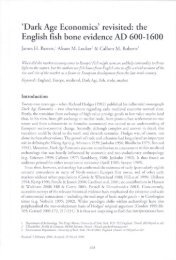Piracy in Late Roman Britain: A Perspective from the ... - Fiske Center
Piracy in Late Roman Britain: A Perspective from the ... - Fiske Center
Piracy in Late Roman Britain: A Perspective from the ... - Fiske Center
Create successful ePaper yourself
Turn your PDF publications into a flip-book with our unique Google optimized e-Paper software.
PIRACY IN LATE ROMAN BRITAIN: A PERSPECTIVE FROM THE VIKING AGE<br />
339<br />
and Mercia, and almost noth<strong>in</strong>g of East Anglia, precisely because successful raid<strong>in</strong>g seems to<br />
have h<strong>in</strong>dered both <strong>the</strong> production, and <strong>the</strong> survival of, historical records.<br />
Recent research <strong>in</strong> particular has been concerned with test<strong>in</strong>g <strong>the</strong> primary sources aga<strong>in</strong>st <strong>the</strong><br />
archaeological record, and has gone some distance towards ref<strong>in</strong><strong>in</strong>g (and <strong>in</strong> part challeng<strong>in</strong>g)<br />
popular conceptions. However, little has been settled, and summaris<strong>in</strong>g <strong>the</strong> debate on<br />
Scand<strong>in</strong>avian raid<strong>in</strong>g and settlement <strong>in</strong> England, Trafford comments that <strong>the</strong> discourse has<br />
reached a stalemate between those argu<strong>in</strong>g for a large or a small number of Vik<strong>in</strong>g settlers.9<br />
CHRONOLOGICAL DEVELOPMENT<br />
The primary sources that <strong>in</strong>form us about Vik<strong>in</strong>g <strong>in</strong>volvement <strong>in</strong> North-West Europe suggest<br />
that it followed an <strong>in</strong>tensify<strong>in</strong>g trend.10 The first phase, dur<strong>in</strong>g <strong>the</strong> late eighth and early n<strong>in</strong>th<br />
centuries, appears to have comprised opportunist raid<strong>in</strong>g dur<strong>in</strong>g <strong>the</strong> summer period on vulnerable<br />
coastal targets. These early raiders arrived <strong>in</strong> small numbers and relied on hit-and-run tactics,<br />
and <strong>the</strong>re was unlikely to have been prolonged contact between attacker and native. However,<br />
<strong>from</strong> <strong>the</strong> 830s <strong>in</strong> Ireland and <strong>the</strong> 850s <strong>in</strong> England a new phase began, with overw<strong>in</strong>ter<strong>in</strong>g Vik<strong>in</strong>g<br />
'armies' becom<strong>in</strong>g an <strong>in</strong>creas<strong>in</strong>g feature of warfare, and Scand<strong>in</strong>avian warlords play<strong>in</strong>g a<br />
significant role <strong>in</strong> regional affairs. In certa<strong>in</strong> cases <strong>the</strong> situation ultimately progressed to one of<br />
political conquest, for example <strong>the</strong> English Danelaw, <strong>the</strong> duchy of Normandy, and <strong>the</strong> k<strong>in</strong>gdom<br />
of Dubl<strong>in</strong>.<br />
SCALE AND INTENSITY<br />
It is difficult to estimate <strong>the</strong> size of Vik<strong>in</strong>g fleets and <strong>the</strong> numbers of warriors <strong>in</strong>volved <strong>from</strong><br />
contemporary historical sources. Such matters are reported with vary<strong>in</strong>g precision, and even<br />
where specified, <strong>the</strong> size of vessels (and thus <strong>the</strong>ir crew complement) rema<strong>in</strong>s unknown. The<br />
academic debate is presently polarised between those who contend that Vik<strong>in</strong>g armies were<br />
small and those who argue for <strong>the</strong> presence of much larger Scand<strong>in</strong>avian forces.11<br />
This issue is perhaps less contentious with regard to <strong>the</strong> first raid<strong>in</strong>g phase, if only because<br />
<strong>the</strong> scope for different estimates is fairly small. The sources suggest that raids were carried<br />
out by <strong>in</strong>dividual ships or small fleets, and were conf<strong>in</strong>ed to <strong>the</strong> summer months when sail<strong>in</strong>g<br />
conditions were most favourable; <strong>the</strong> first recorded contact with <strong>the</strong> Vik<strong>in</strong>gs <strong>in</strong> England, for<br />
example, <strong>in</strong>volved a group of three ships which landed at Portland <strong>in</strong> A.D. 789. The pirates<br />
<strong>in</strong>volved <strong>in</strong> <strong>the</strong> earliest raids aga<strong>in</strong>st Ireland (A.D. 795-836) also arrived <strong>in</strong> s<strong>in</strong>gle ships or very<br />
small 'fleets'. Crew sizes are uncerta<strong>in</strong>, but limited evidence of n<strong>in</strong>th-century Vik<strong>in</strong>g ships<br />
suggests complements of between 25 and 70 persons,12 so we might envisage forces of a few<br />
tens up to about 200.<br />
From our foreshortened historical perspective, Vik<strong>in</strong>g raid<strong>in</strong>g appears at first glance to be a<br />
cont<strong>in</strong>uous feature of <strong>the</strong> late eighth and early n<strong>in</strong>th centuries. This, however, is not <strong>the</strong> case.<br />
Between A.D. 795 and 807 <strong>the</strong>re were only ten recorded attacks on Irish monasteries (<strong>in</strong>clud<strong>in</strong>g<br />
<strong>the</strong> island sites of Iona and Skye), and no more are known for <strong>the</strong> next 15 years. Between A.D.<br />
822 and 829 a fur<strong>the</strong>r 15 attacks are recorded, br<strong>in</strong>g<strong>in</strong>g <strong>the</strong> total to 25 over a period of 34 years.<br />
A broadly similar pattern can be observed <strong>in</strong> Brita<strong>in</strong> dur<strong>in</strong>g <strong>the</strong> same period. Sawyer comments<br />
9 Trafford 2000, 21.<br />
10 Sawyer 1997.<br />
11 Sawyer 1962; Brooks 1979.<br />
12 Haywood 1995, 48.









